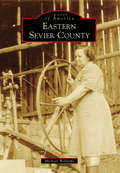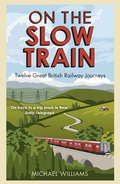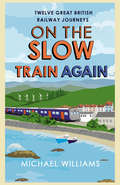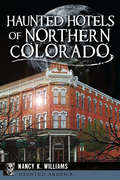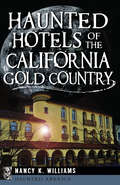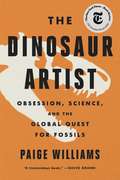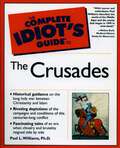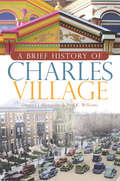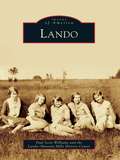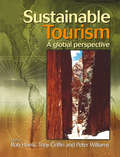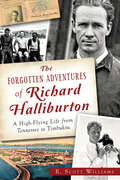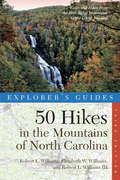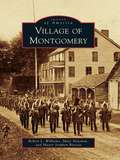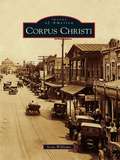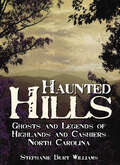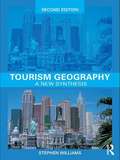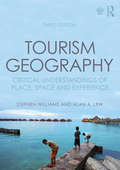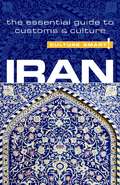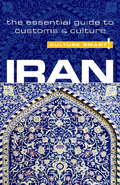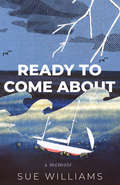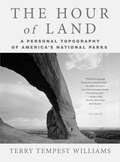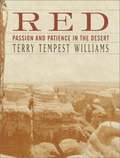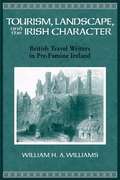- Table View
- List View
Eastern Sevier County (Images of America)
by Michael WilliamsEastern Sevier County rests in the foothills of the Great Smoky Mountains National Park. The area is home to the small communities of Foxfire Mountain, Pittman Center, Jones Cove, Richardson's Cove, Locust Ridge, and Pearl Valley. Foxfire Mountain is best known today for the adventure park and agri-tourist destination brought to life by the Postlewaite family, yet it also boasts a colorful history that includes Benjamin Owens, a judge notorious for hanging convicts from an oak tree on his property. Locust Ridge is the birthplace of country music legend Dolly Parton, and it has been reported that her father compensated the attending physician who delivered Dolly with a bag of cornmeal. Pittman Center, originally a Cherokee hunting ground, is now the largest community in this portion of the county. Strangely, the town is named for Dr. Eli Pittman of New York, who assisted local minister John Burnett with fundraising to build a school to serve the area. Pittman Center is now a favorite destination for those enjoying the Great Smoky Mountains National Park.
On The Slow Train: Twelve Great British Railway Journeys
by Michael Williams'A trip back in time' DAILY TELEGRAPHA love of railways, a love of history, a love of nostalgia.______________________________Get ready to board the slow train to another era, to a time when travel meant more than hurrying from one place to the next. On the Slow Train will reconnect you with that long-missed need for escape, and reminds us to lift our heads from the daily grind and remember that there are still places in Britain where we can take the time to stop and stare. This book is a paean to another age: before milk churns, train porters and cats on seats were replaced by security announcements and Burger King wrappers. These 12 spectacular journeys will help free us from what Baudelaire denounced as 'the horrible burden of time.'___________________________________'Captivating' SUNDAY EXPRESS'Deep in our soul, the railways represent an idyll that we love' INDEPENDENT'A magical world, barely changed since the golden age of rail' DAILY MAIL'Superb' RAILYWAY MAGAZINE'Memory lane . . . An intriguing social snapshot' HERITAGE RAILWAY
On the Slow Train Again
by Michael WilliamsMichael Williams has spent the past year travelling along the fascinating rail byways of Britain for this new collection of journeys. Here is the 'train to the end of the world' running for more than four splendid hours through lake, loch and moorland from Inverness to Wick, the most northerly town in Britain. He discovers a perfect country branch line in London's commuterland, and travels on one of the slowest services in the land along the shores of the lovely Dovey estuary to the far west of Wales. He takes the stopping train across the Pennines on a line with so few services that its glorious scenery is a secret known only to the regulars. Here, too, is the Bittern Line in Norfolk and the Tarka Line in North Devon as well as the little branch line to the fishing port of Looe in Cornwall, rescued from closure in the 1960s and now celebrating its 150th anniversary taking families on holiday to the seaside. From the most luxurious and historic - aboard the Orient Express - to the most futuristic - on the driverless trains of London's Docklands Light Railway - here is a unique travel companion celebrating the treasures of our railway heritage from one of Britain's most knowledgeable railway writers.
Haunted Hotels of Northern Colorado (Haunted America)
by Nancy K WilliamsJoin the supernatural guests who have extended their stays from Denver to Estes Park where the Stanley Hotel inspired Stephen King’s The Shining.The haunted hotels of northern Colorado offer chance encounters with wispy apparitions from a fabulous century gone by. The Earl of Dunraven prowls in the night at the Stanley Hotel. Melancholy Carl haunts the halls of the Brook Forest Inn, and Eleanor James tosses pots and pans about at the Elkhorn Lodge. A little boy, tragically drowned, leaves watery footprints in the Hotel Jerome. Book a stay with author Nancy Williams as she explores Colorado’s iconic hotels where spirits aren’t confined to the bar.
Haunted Hotels of the California Gold Country (Haunted America)
by Nancy K WilliamsIn this historic region of northern California, there are hotels where some guests never checked out—even after death . . . Step across the threshold of a haunted hotel in California&’s renowned Gold Country and encounter phantom figures of yesteryear. Wispy apparitions of gentleman guests in Victorian coats and ladies in fashionable flapper gowns glide through the walls, while unexplained sobs and choking gasps disturb the night. There&’s Stan, the Cary House&’s eternal desk clerk, and bachelor ghost Lyle, who tidies the Groveland Hotel. Flo tosses pots and pans in the National&’s kitchen, while the once-scorned spirit of Isabella ties the Sierra Nevada House&’s curtains in knots. From suicidal gamblers to murdered miners, the Mother Lode&’s one-time boomtowns are crowded with characters of centuries past. Book your stay with author Nancy Williams as she explores the history and haunts of the Gold Country&’s iconic hotels. Includes photos!
O Come Ye Back to Ireland: Our First Year In County Claire
by Niall Williams Christine BreenTwo years ago Niall Williams and his wife, Christine Breen, abandoned their urban careers and paychecks and their many comforts to return to the rugged, rural life of their ancestral Ireland. They emigrated back to the land of their forefathers. Answering a sentimental longing to reconnect to the place of their origin, they booked one-way tickets, pooled and budgeted savings, and bundled up their worldly possessions. Niall would write, Christine would paint, and they would soon grow produce and maintain live-stock. The town they settled near was the village of Kilmihil, 12 miles from the sea, on Ireland's western coast. The place is damp, gray and utterly beautiful. The house, her great grandfather's cottage is heated only by turf which Niall must learn to cut from the nearby bogs and burn in the open fireplace. There is no telephone, no chain saw. There are no restaurants, cinemas, subways, cities or sounds other than the wind, the rain and the jackdaws. Christine sets upon the overgrown garden, salvaging the flowers from among the weeds. The garden, she realizes, was first put in by her great grandfather 200 years earlier. Though the skies rain for an entire summer, she manages to paint and even teach aerobics to the local ladies, as she also strives to earn the welcome she finally receives as Jack O'the Grove's granddaughter.Niall learns to kill a chicken, rids the house of a hoard of bees, finds the burial grounds of a mythical giant and ultimately takes a course to learn to be a farmer. Together Niall and Christine brought the farmland of Kiltumper back to life and together they have written this journal, delightfully illustrated with Christine's art. Niall and Christine first met at University College in Dublin, the city where Niall was born and raised. Christine was born in New Jersey and raised in New York. She graduated from Boston College. They have stories and poems published in Ireland in the past 2 years. Before that Christine worked in New York City at a medical journal and Niall was a copywriter at a mass market publishing house, where he also penned a romance newsletter under the name of "Sarah Reynolds."
The Dinosaur Artist: Obsession, Betrayal, and the Quest for Earth's Ultimate Trophy
by Paige WilliamsIn 2012, a New York auction catalogue boasted an unusual offering: "a superb Tyrannosaurus skeleton." In fact, Lot 49135 consisted of a nearly complete T. bataar, a close cousin to the most famous animal that ever lived. The fossils now on display in a Manhattan event space had been unearthed in Mongolia, more than 6,000 miles away. At eight-feet high and 24 feet long, the specimen was spectacular, and when the gavel sounded the winning bid was over $1 million. <p><p> Eric Prokopi, a thirty-eight-year-old Floridian, was the man who had brought this extraordinary skeleton to market. A onetime swimmer who spent his teenage years diving for shark teeth, Prokopi's singular obsession with fossils fueled a thriving business hunting, preparing, and selling specimens, to clients ranging from natural history museums to avid private collectors like actor Leonardo DiCaprio. <p> But there was a problem. This time, facing financial strain, had Prokopi gone too far? As the T. bataar went to auction, a network of paleontologists alerted the government of Mongolia to the eye-catching lot. As an international custody battle ensued, Prokopi watched as his own world unraveled. <p> In the tradition of The Orchid Thief, The Dinosaur Artist is a stunning work of narrative journalism about humans' relationship with natural history and a seemingly intractable conflict between science and commerce. A story that stretches from Florida's Land O' Lakes to the Gobi Desert, The Dinosaur Artist illuminates the history of fossil collecting--a murky, sometimes risky business, populated by eccentrics and obsessives, where the lines between poacher and hunter, collector and smuggler, enthusiast and opportunist, can easily blur. <p> In her first book, Paige Williams has given readers an irresistible story that spans continents, cultures, and millennia as she examines the question of who, ultimately, owns the past.
The Complete Idiot's Guide to the Crusades
by Paul WilliamsYou&’re no idiot, of course. You know the Crusades were a war between Christians and Muslims for control of the Holy Land. However, these bloody conflicts raged over centuries, under changing circumstances, making the whole story difficult to follow. You don&’t have to don armor and cross deserts to relive the Crusades! The Complete Idiot&’s Guide® to the Crusades shows you why these wars began, why they continued for so long, and how their impact on the world still resonates. This Complete Idiot&’s Guide® gives you:• An introduction to the Dark Ages and the Renaissance, and why Pope Urban II would grant absolution to anyone who reclaimed the Holy Land for Christianity.• The origins of such Holy Orders as the Knights Templar, the Hospitallers, and the Teutonic Knights—and the roles they played during the Crusades.• The creation of such items as chastity belts, razors, stained glass, perfume, the crossbow, the compass, and public latrines.• The nobles—Richard the Lion Heart, Louis IX, and Frederick II—and the Muslim leaders—Saladin, Zengi, and Nur ed-Din—who held the lives of thousands in their hands.
A Brief History of Charles Village
by Paul K. Williams Gregory J. AlexanderBaltimore Orioles, infamous bootleggers, novelists of the Jazz Age and famous musicians have all wandered and lived among the stately Victorian homes and vibrant "painted ladies" of Charles Village. From its beginning as a series of country villas for the wealthy elite of Baltimore to escape the crush of downtown, the neighborhood has become a diverse and vibrant cultural hub of the city. Local authors Gregory J. Alexander and Paul K. Williams chart the evolution of this famous Baltimore community and its institutions while telling fascinating tales of some of its most colorful residents.
Lando
by Paul Scott Williams Lando-Manetta Mills History CenterLando is tucked away in eastern Chester County, along the flood plains of Fishing Creek. The quiet community has existed for more than 240 years. Originally settled by yeoman Phillip Walker, who established a plantation, gristmill, and sawmill, Lando became home to Manetta Mills and, for more than 80 years, was one of the world's largest manufacturers of blankets. Lando and Manetta Mills,owned and operated by the Heath family, became a way of life to the residents of the mill hill. There were baseball teams, churches, bands, trains, rivers, schools, and textiles. In Images of America: Lando, readers will experience day-to-day life in a small mill community and see how neighbors and coworkers lived and worked together. Lando shows the commitment of the Heath family to the community, theworkers, and their product. The Heath family did not only invest in the development of Manetta Mills, they also invested in the lives of hundreds of people who have affected thousands of others.
Sustainable Tourism: A Global Perspective
by Peter Williams Rob Harris Tony GriffinSustainable Tourism is vital reading for anyone seeking to understand the complexities associated with sustainable tourism development, and how government and industry have responded to the challenges the concept poses.The major areas addressed in this edited volume are:* perspectives and issues associated with the concept of sustainable tourism development* accreditation, education and interpretation, including specific examples such as Green Globe 21, the European Blue Flag Campaign and the WWF's PAN Parks Programme* sustainable tourism case studies of tourist destination regions, natural areas and tourism enterprises drawn from Africa, Australia, the South Pacific, North America, South-east Asia and the CaribbeanAn impressive international editorial team has combined to present in this text not only a variety of perspectives on sustainable tourism development, but also significant insights into barriers, challenges and current industry and government responses to it in various parts of the globe. 'Sustainable Tourism' will be a welcome addition to the libraries of tourism industry professionals, individuals involved in the management of natural areas; tourism policy makers; tourism academics; and students with an interest in the future sustainability of tourism and the industry that supports it.
The Forgotten Adventures of Richard Halliburton: A High Flying Life from Tennessee to Timbuktu
by R. Scott WilliamsA biography of the charismatic world traveler whose daredevil exploits thrilled millions in the early twentieth century. Born in 1900, Richard Halliburton ran away from his hometown of Memphis, Tennessee, at the age of nineteen to lead an extraordinary and dramatic life of adventure. Against the backdrop of the Roaring Twenties and the Great Depression, Halliburton&’s exploits around the globe made him an internationally known celebrity and the most famous travel writer of his time. From climbing Mount Olympus in Greece to swimming the Panama Canal and flying all the way to Timbuktu, Halliburton experienced and wrote about adventures that others never even believed possible. His youthful spirit and bohemian lifestyle won the hearts of millions, and this absorbing biography tells his story. &“He was Marco Polo and Indiana Jones wrapped up in one, with P.T. Barnum&’s flippancy and James Bond&’s bravado, capped off by F. Scott Fitzgerald&’s aristocratic good looks and manners.&” —Smithsonian &“A concise new biography [that] covers the life of a man of marvels.&” —Memphis Magazine
Explorer's Guide 50 Hikes in the Mountains of North Carolina (Third Edition)
by Robert L. WilliamsThis updated third edition offers day hikes for all skill levels and abilities, including an underground hike through an old gold mine and a climb to the top of the highest peak along the Blue Ridge Parkway. The mountain ranges of North Carolina—from the Blue Ridge and Great Smokies to the southern foothills—are distinguished by steep gorges, spectacular waterfalls, lush forests, open vistas and temperate weather, making them a popular hiking destination in every season. This updated third edition offers day hikes for all skill levels and abilities, including an underground hike through an old gold mine and a climb to the top of the highest peak along the Blue Ridge Parkway. In addition to trailhead directions, hiking distances and times, safety tips, and topographic maps, you’ll also find folk stories, historical anecdotes, and natural history information.
Village of Montgomery (Images of America)
by Robert L. Williams Marc Newman Mayor Stephen BresciaNoted for its picturesque historic districts and venerable homes, the village of Montgomery is nestled into northern Orange County, bounded by the Wallkill River in the shadow of the Comfort Hills. Filled with rare photographs dating from the 1870s to the present, Village of Montgomery focuses on the history of the hamlet and its churches, roads, businesses, schools, and cemeteries, providing insight into how village residents lived, worked, and played in years past. The insightful text accompanying each photograph reveals intriguing and little-known facts about the village and its people.
Corpus Christi
by Scott WilliamsLatin for "Body of Christ," Corpus Christi is a popular vacation destination, military town, and thriving seaport. Legend has it that Spanish explorer Alonso Álvarez de Pineda discovered and named Corpus Christi Bay in 1519. Henry L. Kinney, a trader who arrived in the area around 1838, is credited with starting the trading post that eventually grew into one of Texas's largest cities and became home to one of the nation's busiest ports. This "Sparkling City by the Sea" balances growth and industry with an appreciation for the air, water, and wildlife that attract both sportsmen and environmentalists. Corpus Christi is a bilingual, bicultural community that embraces both its Mexican and American roots.
Haunted Hills: Ghosts and Legends of Highlands and Cashiers, North Carolina (Haunted America)
by Stephanie Burt WilliamsThe author of Wicked Charlotte roots out the spirited secrets of two small towns deep in the Appalachian Mountains. When the sun slips behind the trees and shadows lengthen near dusk, the mountains and valleys of Highlands and Cashiers whisper their tales of lost loves, deals gone bad, and ghosts who walk the night. This tourist destination is rich in folklore and legend—from rumors of a magical mountain volcano to the ghost of a white owl. Learn the stories and firsthand accounts of hauntings and the hard to explain. Listen to the voices winding through the hemlocks, or is it just the wind? Includes photos!
Tourism Geography: A New Synthesis
by Stephen WilliamsFor human geographers, a central theme within the discipline is interpreting and understanding our changing world a world in which geographic patterns are constantly being reworked by powerful forces of change. These forces include population shifts, new patterns of economic production and consumption, evolving social and political structures, new forms of urbanism, and globalisation and the compressions of time and space that are the product of the ongoing revolutions in information technology and telecommunications. This book attempts to show how tourism has also come to be a major force for change as an integral and indispensable part of the places in which we live, their economies and their societies. When scarcely a corner of the globe remains untouched by the influence of tourism, this is a phenomenon that we can no longer ignore. Tourism is also an intensely geographic phenomenon. It exists through the desire of people to move in search of embodied experience of other places as individuals and en mass and at scales from the local to the increasingly global. Tourism creates distinctive relationships between people (as tourists) and the host spaces, places and people they visit, which has significant implications for destination development and resource use and exploitation, which are exhibited through a range of economic, social, cultural and environmental impacts that have important implications for local geographies. This third edition of "Tourism Geography: " "critical understandings of place, space and experience "presents an essential understanding of critical perspectives on how tourism places and spaces are created and maintained. Drawing on the holistic nature of geography, a range of social science disciplinary views are presented, including both historical and contemporary perspectives. Fundamentally, however, the book strives to connect tourism to key geographical concepts of globalisation, mobility, production and consumption, physical landscapes, and post-industrial change. The book is arranged in five parts. Part I provides an overview of fundamental tourism definitions and concepts, along with an introduction to some of the major themes in contemporary geographic research on tourism, which are further developed in subsequent chapters of this book. In Part II the discussion focuses on how spatial patterns of modern tourism have evolved through time from regional to global geographies. Part III offers an extended discussion of how tourism relates to places that are toured through their economic landscape, contemporary environmental change and socio-cultural relations. Part IV explores a range of major themes in the geographies of tourism, including place creation and promotion, the transformation of urban tourism, heritage and place identity, and creating personal identity through consumption, encounters with nature and other embodied forms of tourism experience. Part V turns to applied geography with an overview of the different roles of planning for tourism as a means of spatial regulation of the activity, and a look at emerging themes in the critical geography of contemporary and future geographies of tourism. This third edition has been revised by Dr Alan A. Lew, who becomes the new co-author of "Tourism Geography. " Some of the major revisions that I have incorporated include moving most of the case study boxes to the website http: //tourismgeography. com, which will provide a growing wealth of new case studies, over time. I have also incorporated new material, reorganised some of the content to balance the topics covered, created a new concluding chapter that explores some recently emerging perspectives in critical tourism geography, and re-written the text to make it more accessible to a global English-speaking world. That said, the book is still very much the work of Dr Stephen Williams. As such, it maintains its original concise yet comprehensive review of contemporary tourism geography an
Tourism Geography: Critical Understandings of Place, Space and Experience (Contemporary Human Geography Ser.)
by Stephen Williams Alan A. LewFor human geographers, a central theme within the discipline is interpreting and understanding our changing world - a world in which geographic patterns are constantly being reworked by powerful forces of change. These forces include population shifts, new patterns of economic production and consumption, evolving social and political structures, new forms of urbanism, and globalisation and the compressions of time and space that are the product of the ongoing revolutions in information technology and telecommunications. This book attempts to show how tourism has also come to be a major force for change as an integral and indispensable part of the places in which we live, their economies and their societies. When scarcely a corner of the globe remains untouched by the influence of tourism, this is a phenomenon that we can no longer ignore. Tourism is also an intensely geographic phenomenon. It exists through the desire of people to move in search of embodied experience of other places as individuals and en mass and at scales from the local to the increasingly global. Tourism creates distinctive relationships between people (as tourists) and the host spaces, places and people they visit, which has significant implications for destination development and resource use and exploitation, which are exhibited through a range of economic, social, cultural and environmental impacts that have important implications for local geographies. This third edition of Tourism Geography: critical understandings of place, space and experience presents an essential understanding of critical perspectives on how tourism places and spaces are created and maintained. Drawing on the holistic nature of geography, a range of social science disciplinary views are presented, including both historical and contemporary perspectives. Fundamentally, however, the book strives to connect tourism to key geographical concepts of globalisation, mobility, production and consumption, physical landscapes, and post-industrial change. The book is arranged in five parts. Part I provides an overview of fundamental tourism definitions and concepts, along with an introduction to some of the major themes in contemporary geographic research on tourism, which are further developed in subsequent chapters of this book. In Part II the discussion focuses on how spatial patterns of modern tourism have evolved through time from regional to global geographies. Part III offers an extended discussion of how tourism relates to places that are toured through their economic landscape, contemporary environmental change and socio-cultural relations. Part IV explores a range of major themes in the geographies of tourism, including place creation and promotion, the transformation of urban tourism, heritage and place identity, and creating personal identity through consumption, encounters with nature and other embodied forms of tourism experience. Part V turns to applied geography with an overview of the different roles of planning for tourism as a means of spatial regulation of the activity, and a look at emerging themes in the critical geography of contemporary and future geographies of tourism. This third edition has been revised by Dr Alan A. Lew, who becomes the new co-author of Tourism Geography. Some of the major revisions that I have incorporated include moving most of the case study boxes to the website http://tourismgeography.com, which will provide a growing wealth of new case studies, over time. I have also incorporated new material, reorganised some of the content to balance the topics covered, created a new concluding chapter that explores some recently emerging perspectives in critical tourism geography, and re-written the text to make it more accessible to a global English-speaking world. That said, the book is still very much the work of Dr Stephen Williams. As such, it maintains its original concise yet comprehensive review of contemporary tourism geography and the ways in which geographers critically interpret this important global phenomenon. It is written as an int...
Culture Smart! Iran
by Stuart WilliamsThis book aims to show how life in Iran really is and how visitors can feel comfortable in its society. It explains the basic culture of a country full of surprises. Despite Iran's deep commitment to Islam, the pre-Islamic Zoroastrian past is still part of everyday life. Its language, Farsi, shares the same linguistic roots as English or French. It is a country where one of the more genuine democracies in the Middle East is overlaid by an unelected theocracy. And where "no thank you" really does sometimes mean "yes please."
Iran - Culture Smart!
by Stuart WilliamsCulture Smart! provides essential information on attitudes, beliefs and behavior in different countries, ensuring that you arrive at your destination aware of basic manners, common courtesies, and sensitive issues. These concise guides tell you what to expect, how to behave, and how to establish a rapport with your hosts. This inside knowledge will enable you to steer clear of embarrassing gaffes and mistakes, feel confident in unfamiliar situations, and develop trust, friendships, and successful business relationships.Culture Smart! offers illuminating insights into the culture and society of a particular country. It will help you to turn your visit-whether on business or for pleasure-into a memorable and enriching experience. Contents include* customs, values, and traditions* historical, religious, and political background* life at home* leisure, social, and cultural life* eating and drinking* dos, don'ts, and taboos* business practices* communication, spoken and unspoken"Culture Smart has come to the rescue of hapless travellers." Sunday Times Travel"... the perfect introduction to the weird, wonderful and downright odd quirks and customs of various countries." Global Travel"...full of fascinating-as well as common-sense-tips to help you avoid embarrassing faux pas." Observer"...as useful as they are entertaining." Easyjet Magazine"...offer glimpses into the psyche of a faraway world." New York Times
Ready to Come About
by Sue WilliamsThree hundred nautical miles from shore, I‘m cold and sick and afraid. I pray for reprieve. I long for solid ground. And I can‘t help but ask myself, What the hell was I thinking? When Sue Williams set sail for the North Atlantic, it wasn’t a mid-life crisis. She had no affinity for the sea. And she didn’t have an adventure-seeking bone in her body. In the wake of a perfect storm of personal events, it suddenly became clear: her sons were adults now; they needed freedom to figure things out for themselves; she had to get out of their way. And it was now or never for her husband, David, to realize his dream to cross an ocean. So she’d go too. Ready to Come About is the story of a mother’s improbable adventure on the high seas and her profound journey within, through which she grew to believe that there is no gift more precious than the liberty to chart one’s own course, and that risk is a good thing … sometimes, at least.
The Hour Of Land: A Personal Topography Of America's National Parks
by Terry Tempest WilliamsAmerica’s national parks are breathing spaces in a world in which such spaces are steadily disappearing, which is why more than 300 million people visit the parks each year. Now Terry Tempest Williams, the New York Times bestselling author of the environmental classic Refuge and the beloved memoir When Women Were Birds, returns with The Hour of Land, a literary celebration of our national parks and an exploration of what they mean to us and what we mean to them. From the Grand Tetons in Wyoming to Acadia in Maine to Big Bend in Texas, Williams creates a series of lyrical portraits that illuminate the unique grandeur of each place while delving into what it means to shape a landscape with its own evolutionary history into something of our own making. Part memoir, part natural history, and part social critique, The Hour of Land is a meditation and a manifesto on why wild lands matter to the soul of America.
Red: Passion and Patience in the Desert
by Terry Tempest Williams"It is a simple equation," writes Terry Tempest Williams, "place + people = politics." Nowhere is this more apparent than in the American West, where millions of acres of wilderness are at stake in the redrock desert of southern Utah. "How are we to find our way toward conversation?" she asks. One story at a time. Red traces Williams's lifelong love of and commitment to the desert, as she explores what draws us to a place and keeps us there. It brings together the lyrical evocations of Coyote's Canyon and Desert Quartet with new essays of great power and originality, essays that range from a family discussion on the desert tortoise to an investigation of slowness to startling encounters with Anasazi artifacts (including a ceremonial sash made of scarlet macaw feathers). Pursuing the question of why America's redrock wilderness matters to the soul of this country, Red bridges the divide between the political and the poetic and shows how this harshest and most fragile of landscapes inspires a soulful return to "wild mercy." The preservation of wildness is not simply a political process but a spiritual one. With grace, humor, and the subtleties of her perception, Williams reminds us of what we have forgotten in the chaos of our lives and what can be reclaimed in the stillness of the desert. Red is further proof that the writings of Terry Tempest Williams possess a revelatory power and an emotional intelligence at once rare and authentic.
Stringbean's Trip to the Shining Sea
by Vera B. Williams Jennifer WilliamsStringbean describes his trip to the west coast in a series of postcards.
Tourism, Landscape, and the Irish Character
by William H. A. WilliamsBritish tourists in Ireland in the eighteenth and nineteenth centuries were both charmed and repulsed. Picturesque but poor, abject yet sublime in its Gothic melancholy, the Ireland they experienced did not fit their British sense of progress, propriety, and Protestantism. Tourism, Landscape, and the Irish Characterdraws from more than one hundred accounts by English, Scottish, Welsh, and Anglo-Irish tourists written between 1750 and 1850 to probe the moral judgments British observers made about the Irish countryside and its native inhabitants. Whether consciously or not, these travel writers defined their own British identity in opposition to a perceived Irish strangeness: the rituals of Catholicism, the seemingly histrionic lamentations of the funeral wake, cemeteries with displays of human bones, the archaic Irish language or the Celtic-infused English that they heard spoken. Overlooking the acute despair in England's own industrial cities, they opined that the poverty, bog lands, and ill-thatched houses of rural Ireland indicated failures of the Irish character. By the eve of the Famine of the 1840s, travel writers were employing stereotypes of Celtic, Catholic carelessness in the south of Ireland and Saxon neatness and enterprise in predominantly Protestant Ulster, even calling for "Saxon" colonization of the west of Ireland. The Famine cleared the land of many of the peasants, but the western landscape, magnificent in its scenery but poor in its soil, eventually defeated most of the British "colonists," leaving the region to an ever-increasing number of tourists who could enjoy the picturesque mountainscapes without the distracting contradiction of an impoverished populace. "Superb book. Students of tourism and national identity, as well as of British and Irish history, will all find a great deal of interest in this text. "-Eric Zuelow,H-Travel "Certainly among the most comprehensive and engaging explorations of this literature yet to appear, not only for what it says about British travelers in Ireland but also for what it indirectly reveals about life I pre-famine Ireland itself. "-Mark Doyle,Journal of British Studies
